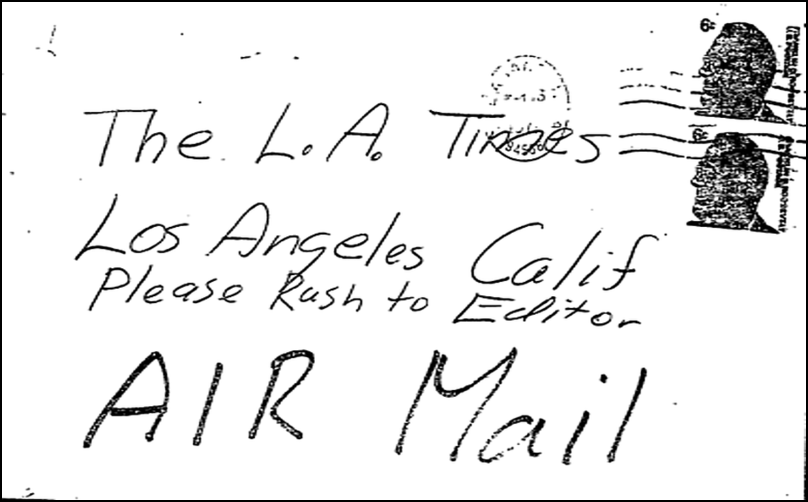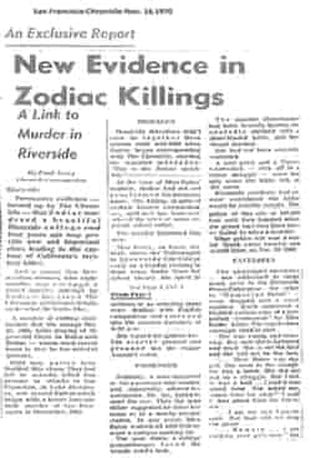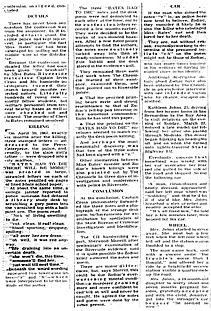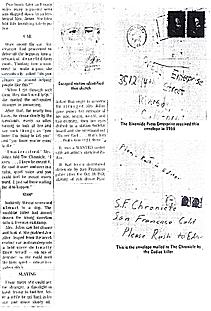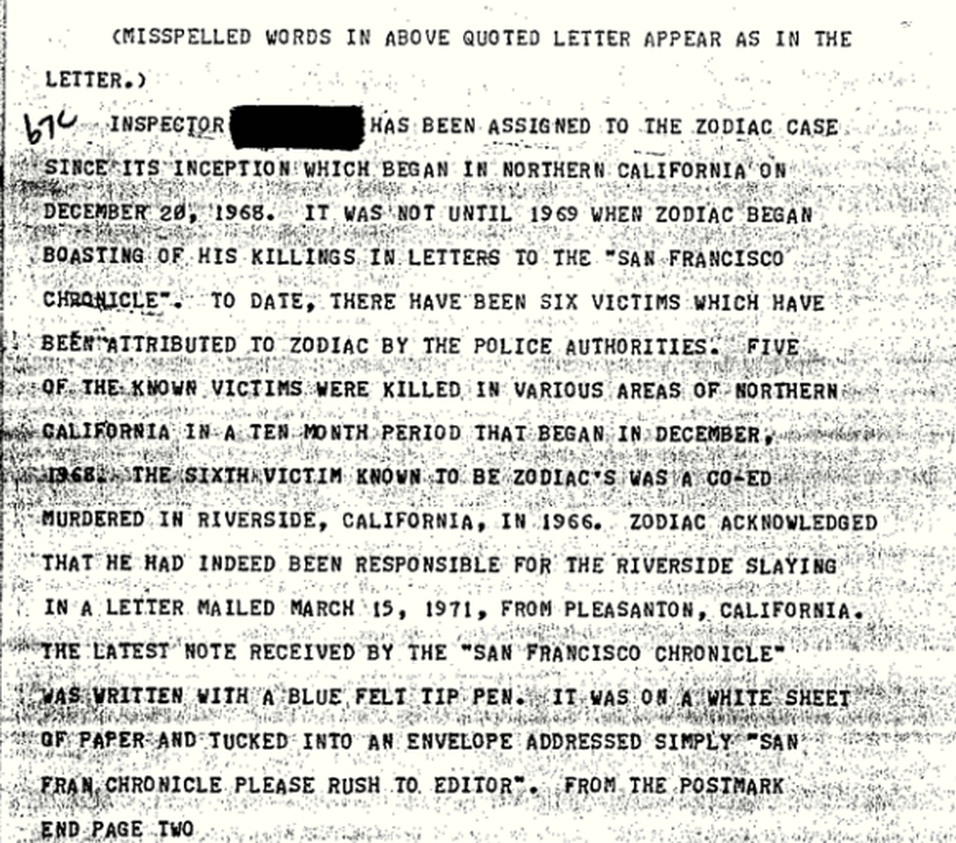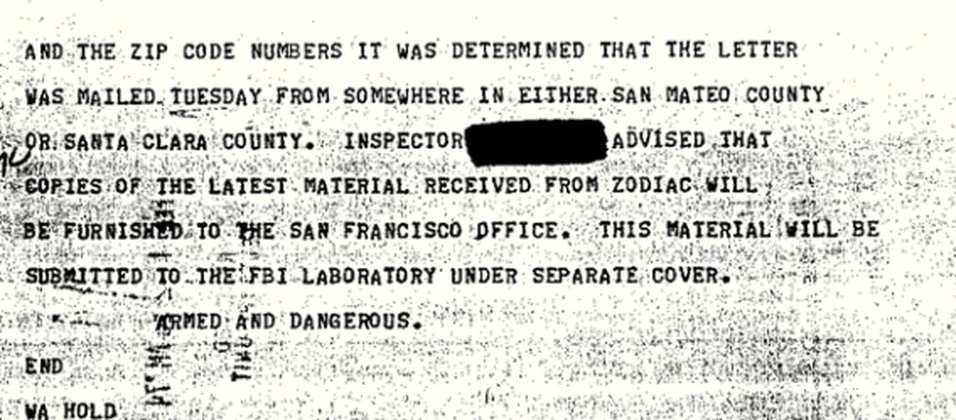 Click to enlarge letter Click to enlarge letter
In the Los Angeles letter, mailed on March 13th 1971, the Zodiac had now laid claim to an inflated victim count of 17+, accompanied by his usual jibe at police of SFPD-0. The letter bore the postmark of Pleasanton, Alameda County, a suburb in the San Francisco Bay Area. It was addressed to the Los Angeles Times and read:
"This is the Zodiac speaking Like I have allways said, I am crack proof. If the Blue Meannies are evere going to catch me, they had best get off their fat asses + do something. Because the longer they fiddle + fart around, the more slaves I will collect for my after life. I do have to give them credit for stumbling across my riverside activity, but they are only finding the easy ones, there are a hell of a lot more down there. The reason I'm writing to the Times is this, They don't bury me on the back pages like some of the others". Paul Avery, a reporter at the San Francisco Chronicle, unearthed a connection between Riverside and the Bay Area murders, suggesting that the Zodiac Killer may have been responsible for the murder of Cheri Jo Bates in Riverside on October 30th 1966 - and to which the Zodiac either laid claim to, or part indicated his involvement in, by stating in this correspondence: "I do have to give them credit for stumbling across my riverside activity". However, Paul Avery was not the first person to propose a possible connection between the two cases. This was suggested at least a year earlier in a memorandum mailed from Riverside to Napa County on October 20th 1969, after a phone call days earlier between Chief of Police Thomas Kinkead and Sheriff of Napa County Earl Randol. The letter from Kinkead detailed the similarities between the cases and intimated that the information may assist investigators in the Bay Area. "It might be worthwhile to note that just outside the city limits of Riverside is located March Air Force Base, a SAC base. Physical evidence found at the scene of our crime indicated that heel prints found near the body were made by a heel that was manufactured for military and other government agencies, including prisons. We were able to lift some latent fingerprints from the victim's vehicle. These prints were not identified. Our unidentified prints are on file with the FBI under the FBI file No 32-27195, Latent case No 73096. Copies of the latent lifts from your homicide were obtained from CII and sent to the FBI for comparison with the latent lifts in our investigation".  Car chase scene from Vanishing Point Car chase scene from Vanishing Point
Everybody knows the Blue Meanies connection from Yellow Submarine - a fictional army of beings who allegorically represent all the bad people in the world. The author of the 1971 letter used this to represent the police. People's Park in Berkeley, California is a park located off Telegraph Avenue, bounded by Haste and Bowditch streets and Dwight Way, near the University of California, Berkeley. The park was created during the radical political activism of the late 1960s. The local Southside neighborhood was the scene of a major confrontation between student protesters and police on May 15th 1969. Reinforcements were called in from the Alameda County Sheriff’s Office, who arrived carrying shotguns and shells of buckshot. They wore pale blue jumpsuits and were quickly nicknamed the Blue Meanies. The author of the 1971 letter used the term "Blue Meannies", but notably, the letter was mailed from Alameda County rather than San Francisco.
Vanishing Point, which previewed in the January of 1971, had the usual trailers, and was released to the general public on March 13th 1971, the exact mailing date of the Los Angeles letter, presumably authored by the Zodiac Killer. Here is some of the wording from the trailer: "They want to get him and put him away, but there'll have to catch him first". The author of the Los Angeles letter stated "If the Blue Meannies are evere going to catch me, they had best get off their fat asses + do something". The trailer of the film continued with a radio host from KOW reporting the chase "And there goes the Challenger being chased by the Blue, Blue Meanies on wheels". So, was the Vanishing Point trailer the inspiration for the March 13th 1971 Los Angeles letter, with its mailing date deliberately manufactured to marry up with the release date of the film? The Los Angeles letter arrived six months after the disappearance of Donna Ann Lass, who vanished close to the end of her shift at the Sahara Tahoe Hotel & Casino on September 6th 1970, never to be seen again. The final scene in the Vanishing Point movie was filmed in Cisco, Utah, but in the film it was portrayed as Cisco, California. This is the location that the film's main character, Kowalski, met his death. Cisco, California is 10.55 miles west of Clair Tappaan Lodge, the Sierra Club identified by former detective Harvey Hines as the location depicted on the Pines Card, in all likelihood mailed by the Zodiac Killer on March 22nd 1971, referencing the disappearance and likely murder of Donna Lass. Cisco was 15 miles west of the Donner Memorial State Park. In another strange case of zynchronisity, the officer overseeing the conclusion to Kowalski's death after he ran his 1970 Dodge Challenger into the roadblock of bulldozers, was the character Deputy Collins played by Robert Donner. The Dodge Challenger was substituted in the film for the final crash scene with an explosives laden 1967 Chevrolet Camaro. The vehicle driven by Donna Lass at the time she vanished from Lake Tahoe was a 1968 Chevrolet Camaro. 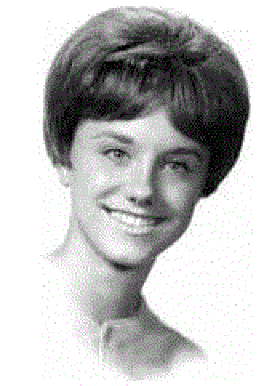 Cheri Jo Bates Cheri Jo Bates
It would take another 13 months for Paul Avery to uncover the connection between the Zodiac Killer and Riverside, and much to the embarrassment of law enforcement published the story in the San Francisco Chronicle in an exclusive report entitled New Evidence in Zodiac Killings - A link to murder in Riverside on November 16th 1970. Four months later, the Zodiac Killer would respond with the above letter effectively staking his claim to the Cheri Jo Bates murder and declaring there were more crimes down south for which he was responsible.
The San Francisco Chronicle article opened with the lines "Persuasive evidence-Turned up by The Chronicle-that Zodiac murdered a beautiful Riverside college coed four years ago may provide new and important clues leading to the capture of California's mystery killer. And a young San Bernadino woman, who eight months ago escaped a weird murder attempt by Zodiac, has given The Chronicle additional details as to what he looks like. A number of chilling similarities link the savage October 30th 1966 knife slaying of 18 year old Cheri Jo Bates with Zodiac-whose most recent boast is that he has killed 14 persons". View the full newspaper article here or to open the individual pages click the images in the sidebar. Remember to click the opened image a second time to magnify. Many Riverside police investigators were reluctant to admit a link between the Cheri Jo Bates murder and the Zodiac killings in the Bay Area, although Questioned Documents Examiner Sherwood Morrill, who worked on many of the Zodiac letters, believed the Confession Letter in the Riverside case, along with handwriting from the Bates letters and the Riverside Desktop Poem to be from the Zodiac Killer. The typed Confession Letter was mailed on November 29th 1966, the Riverside Desktop Poem was discovered in the December of 1966 by a janitor at the Riverside City College library and three 'Bates letters' were mailed on April 30th 1967, sent to Joseph Bates, the Riverside Press Enterprise and the Riverside Police. |
PART ONE
PART TWO
PART THREE
PART FOUR
CLAIR S. TAPPAAN
Clair Sprague Tappaan (May 14, 1878 – November 30, 1932) was an American lawyer, professor and jurist who was on the faculty of the University of Southern California Law School from its formation as an official school of the university in 1904 until 1928, and served as a judge of the Los Angeles County Superior Court and California Court of Appeal from 1927 until his death in 1932. Tappaan suffered a fatal heart attack at age 54 while walking to his office in downtown Los Angeles, shortly after addressing a luncheon of the Los Angeles Bar Association. His death was ruled the result of chronic myocarditis and sclerosis of the left coronary artery. He was survived by his wife, the former Mary E. Darling, whom he married on May 12, 1906. Their only child Francis was an All-American for the USC football team in 1929. Tappaan was a longtime official of the Sierra Club, serving as its fifth president, from 1922 to 1924, and on the board of directors from 1912 until his death. At the time of Tappaan's death, Sierra Club members were organizing to build a ski lodge on Donner Pass in the Sierra Nevada Mountains of Northern California. One Lodge founder, Lewis Clark, said in about 1989 that they named the yet-unnamed lodge after Tappaan to use his popularity to help with fundraising. The Lodge opened on Christmas Eve, 1934, according to Lodge oldtimer Frank Shoemaker. Clair Tappaan Lodge is the Sierra Club's largest and most popular lodge, known among its many supporters as the Sierra Club's "flagship lodge". Tappaan's photo hangs in the entry. Wikipedia |
| ZODIAC CIPHERS |
|

